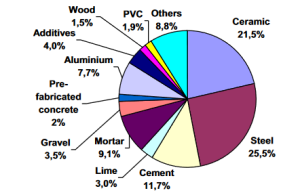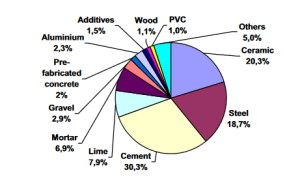21 Building Materials of the Pacific Northwest
Chase
Intro
The Pacific Northwest is home to a heavily diverse ecosystem with vast amounts of natural resources that are used in our daily lives. From the food that we eat to the wood that is framed in our homes, these natural resources are a key part of our lives, and therefore, where we get these resources from and how that affects our ecosystem is important to know. More specifically, this chapter will focus on the use of concrete, steel, and wood in our construction projects and how they affect our local forest populations.
The most commonly used materials in construction in the Pacific Northwest are concrete, steel, and wood. Each of these materials are unique in their own ways, such as how concrete affects the environment through its excessive use, the heavy impact steel has on carbon emissions, or the many benefits wood has in its use in construction, if used in a sustainable manner. Comparing these materials and understanding ways to deter their impact on our forests is an important step to fighting against climate change.
What is Concrete?
Most recognizable in its use in roads and foundations, concrete is an essential component of modern day construction, with its use being widely adapted across the world for over 200 years. Due to relatively low procurement costs, ease of use, wide availability, and more, concrete is the material of choice for many construction projects. There are many downsides to the use of concrete however, mainly, how concrete is manufactured. As said by Tarun Naik in their peer reviewed report on concrete sustainability, “Foundries in the United States generate more than 7 million t(ons) of by-products. Wisconsin alone produces almost 1.1 million t(ons) of foundry by-products, including foundry sand and slag.” This incredible amount of yearly waste goes into landfills, polluting the surrounding environment and increasing the economic costs of production. While there are projects currently underway to improve the sustainability of concrete, such as better managing production waste or through change of manufacturing materials, the main way to improve concrete is to replace the polluting portland cement (the most commonly used material in the production of concrete) used in its production with more sustainable, non-cementitious materials. Continuing with Tarun’s report on concrete, “With replacement of cement with other recyclable resources, worldwide CO 2 emissions would be reduced. A replacement of 50% of cement worldwide by other cementitious materials would reduce CO 2 emissions by more than 1 billion t. This is equivalent to removing approximately one-quarter of all automobiles in the world.” Tackling emissions at the source is a key way in reducing emissions, in turn reducing the amount of CO 2 in the atmosphere in need of sequestration, while still keeping a reliable construction resource in use for developing nations and important infrastructure, such as affordable housing or public infrastructure.[1]
Steel and the Environment
Used in many forms, steel is common in the modern world. From high rise skyscrapers to our own homes, steel is essential to constructing our cities. But what most people don’t see is the underlying damages that steel does to local environments. One of the most energy intensive construction materials to use, steel accounts for over 25% (figure 1) of global material energy consumption [2]. While energy consumption is high, what is more worrying is the amount of pollutants the manufacturing of steel creates. In a recent 2019 report from P.V. Nidheesh and M. Suresh Kumar, they observed that “Carbon dioxide emission from the steel industry is around 997 kg per ton of steel and it accounts for 4 to 5% of global carbon dioxide emissions.” [3].

Steel has a heavy impact on the environment from its heavy reliance on raw materials and energy [4], but its effects can be reduced in meaningful ways to improve sustainability. Some of these methods include the use of biomass fuel for arc furnaces, electrolysis of iron ore to produce reduced iron,[5]. and the increased use of prefabricated steel construction with integrated use of recycled steel. [6]. In particular, the last method shows the most merit in terms of readily available solutions. Prefabrication is a simple way to vastly cut down on material waste, leading to lower resource consumption and energy demands, while also providing greater access to sustainability tools. This is due to prefabrication being completed at factories that are able to be streamlined with more energy efficient tools and lesser polluting resources.[7]
Steel is a critical resource in modern society, being used in critical infrastructure projects such as hospitals and affordable housing. Keeping steel available as a more sustainable resource will be key to lessening the overall impact that construction has on the environment.
Wood in the PNW
One of the many things that the Pacific Northwest is known for is its vast forests. Home to thousands of different species [8], Pacific Northwest forests are an amazing aspect of nature. One of the many resources that these forests provide is timber for use in local construction. Compared to other materials, wood is by far the most environmentally friendly and sustainable. Wood used in construction contributes the least amount of carbon emissions in its manufacture per square meter of floor space when compared to other common materials[9](figure 2). The embodied energy of wood, when compared to steel and concrete, is also significantly lower [10], leading to a lesser carbon footprint. Wood is also structurally strong, giving way to many different applications and alternatives to other, more environmentally detrimental materials such as steel or concrete. A great example of this would be the use of Mass Timber in major construction projects.

Unlike steel and concrete, wood is a renewable resource. Trees that are cut down can be regrown again. But, even regrowing trees can be controversial, as talked in more detail here. The idea of using large amounts of trees to reduce our reliance on both concrete and steel leads to the main argument against wood being used for construction, the way it is logged. Unsustainable logging leads to the destruction of forest ecosystems and those who rely on the forests as a way of life[11]. However, when logging for timber is done in a sustainable manner, there are very little downsides to wood in construction. Sustainable logging consists of a few different factors, including being Forest Stewardship Council certified, protecting and conserving biodiversity, and harvesting in a way that limits waste and protects old growth trees.
Wood is a widely available resource that has high durability and a low carbon footprint.[12] But in order to make use of this, forests must be respected and utilized in a sustainable way such that there is little to no impact on local forest populations.
Conclusion
Protecting forest populations is an important step in fighting against climate change. There are many small steps that need to be taken in order to achieve this. Focusing on what materials are used in the construction of major and minor projects, and how said materials that are used affect the environment is important to understand. Out of the “big three”, wood, steel, and concrete, wood is by far the most environmentally friendly. But one cannot just throw away steel and concrete, nor can we sustainably log our forests, an important part of our ecosystem, to make up for reductions in other materials. Figuring out how to balance each materials usage, and how to limit their environmental impact is critical in protecting the environments, including the great forests of the Pacific Northwest.
- Naik, Tarun R. “Sustainability of Concrete Construction.” Practice Periodical on Structural Design and Construction, vol. 13, no. 2, 2008, pp. 98–103, https://doi.org/10.1061/(ASCE)1084-0680(2008)13:2(98). Accessed 19 Nov. 2022 ↵
- Ignacio Zabalza Bribián, Antonio Valero Capilla, Alfonso Aranda Usón, Life cycle assessment of building materials: Comparative analysis of energy and environmental impacts and evaluation of the eco-efficiency improvement potential, Building and Environment, Volume 46, Issue 5, 2011,Pages 1133-1140, ISSN 0360-1323, https://doi.org/10.1016/j.buildenv.2010.12.002. Accessed 21 Nov. 2022 ↵
- P.V. Nidheesh, M. Suresh Kumar, An overview of environmental sustainability in cement and steel production, Journal of Cleaner Production, Volume 231, 2019, Pages 856-871, ISSN 0959-6526, https://doi.org/10.1016/j.jclepro.2019.05.251. (https://www.sciencedirect.com/science/article/pii/S0959652619317871) Accessed 21 Nov. 2022 ↵
- Ignacio Zabalza Bribián, Antonio Valero Capilla, Alfonso Aranda Usón, Life cycle assessment of building materials: Comparative analysis of energy and environmental impacts and evaluation of the eco-efficiency improvement potential, Building and Environment, Volume 46, Issue 5, 2011,Pages 1133-1140, ISSN 0360-1323, https://doi.org/10.1016/j.buildenv.2010.12.002. Accessed 21 Nov. 2022 ↵
- P.V. Nidheesh, M. Suresh Kumar, An overview of environmental sustainability in cement and steel production, Journal of Cleaner Production, Volume 231, 2019, Pages 856-871, ISSN 0959-6526, https://doi.org/10.1016/j.jclepro.2019.05.251. (https://www.sciencedirect.com/science/article/pii/S0959652619317871) Accessed 21 Nov. 2022 ↵
- Bassam A. Burgan, Michael R. Sansom, Sustainable steel construction, Journal of Constructional Steel Research, Volume 62, Issue 11, 2006, Pages 1178-1183, ISSN 0143-974X, https://doi.org/10.1016/j.jcsr.2006.06.029. (https://www.sciencedirect.com/science/article/pii/S0143974X06001416) Accessed 21 Nov. 2022 ↵
- Bassam A. Burgan, Michael R. Sansom, Sustainable steel construction, Journal of Constructional Steel Research, Volume 62, Issue 11, 2006, Pages 1178-1183, ISSN 0143-974X, https://doi.org/10.1016/j.jcsr.2006.06.029. (https://www.sciencedirect.com/science/article/pii/S0143974X06001416) Accessed 21 Nov. 2022 ↵
- “Pacific Northwest Research Station: Old Growth--a Unique Ecosystem.” Oregon Wild, Oregon Wild, https://oregonwild.org/pacific-northwest-research-station-old-growth-unique-ecosystem. Accessed 22 Nov. 2022 ↵
- Ignacio Zabalza Bribián, Antonio Valero Capilla, Alfonso Aranda Usón, Life cycle assessment of building materials: Comparative analysis of energy and environmental impacts and evaluation of the eco-efficiency improvement potential, Building and Environment, Volume 46, Issue 5, 2011,Pages 1133-1140, ISSN 0360-1323, https://doi.org/10.1016/j.buildenv.2010.12.002. Accessed 21 Nov. 2022 ↵
- Ignacio Zabalza Bribián, Antonio Valero Capilla, Alfonso Aranda Usón, Life cycle assessment of building materials: Comparative analysis of energy and environmental impacts and evaluation of the eco-efficiency improvement potential, Building and Environment, Volume 46, Issue 5, 2011,Pages 1133-1140, ISSN 0360-1323, https://doi.org/10.1016/j.buildenv.2010.12.002. Accessed 21 Nov. 2022 ↵
- Nerger, Matt. “What Is Sustainable Forestry?” Rainforest Alliance, 25 Oct. 2022, https://www.rainforest-alliance.org/insights/what-is-sustainable-forestry/. Accessed 22 Nov. 2022 ↵
- Ignacio Zabalza Bribián, Antonio Valero Capilla, Alfonso Aranda Usón, Life cycle assessment of building materials: Comparative analysis of energy and environmental impacts and evaluation of the eco-efficiency improvement potential, Building and Environment, Volume 46, Issue 5, 2011,Pages 1133-1140, ISSN 0360-1323, https://doi.org/10.1016/j.buildenv.2010.12.002. Accessed 21 Nov. 2022 ↵

